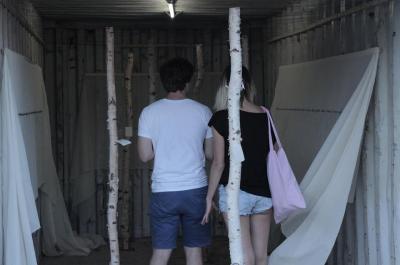
Angela Kaisers: Princesses in waiting

Angela's installation 'BALD' is based on six popular fairy tales collected by the brothers Grimm and discusses the transfer of stories, knowledge and morals. Additionally, it takes a critical stance against the way women are portrayed in these narratives. For the fairy tales were travelling bundles of information and showcases of cultural heritage, mostly but not only national. When analyzing the content of the six chosen fairy tales (The Frog King, Snow White, Sleeping Beauty, Cinderella, Rapunzel, Little Red Riding Hood) it becomes apparent that the basis for all of them is a state of “waiting”. For something, for someone or for an event. In 'BALD' Angela Kaisers breaks down the stories' contents, reduces them to this notion of waiting and thereby highlights and criticizes the moralistic and gender stereotypical elements they purport.
With its play on words the title of the installation introduces the artist's thematic and conceptual approach: the German word “bald” (English “soon”) is associated with waiting for something or someone whereby the English expression “bald” means direct, blunt.
How do you interpret the term "post-internet " age, do you feel you live in one? How does it affect you?
As an art form the internet seems to have lost its edge, it has become conventional. Once something has been seized by the masses it becomes „post“ - so basically we have been living in a post-internet age for quite a while. But „post“ does not mean it is non-existing – on the contrary it has become a mass tool. This does not influence my artworks or my methods but it does influence the distribution of my works.
Your exhibition BALD studies fairy tales, namely the roles in which the female heroes, princesses, are presented. The reflection of gender roles have changed a lot in the past decades. Do you think there is a shift in the interpretation of fairy tales, or do they remain "stuck" in time and space?
A lot of people seem to forget that fairy tales were originally meant to distribute moral standards in the form of narratives. Since I have been a child in the 1980s the brutal aspects of those stories have been softened to make them eligible for children. What has not changed though are the gender stereotypes they portray. I would even say that with turning these narratives into easily digestive material it has become harder to break the standards and stereotypes they purport.
In your work, you interpret German traditional literature. Apart from this project, do you feel an urge to work with the heritage of your country, with your national roots?
In my artworks I discuss all kind of material that has had an influence on my life. This can be the fairy tales that I know from my childhood but also observations I made while I was living and studying abroad.
Do you think there are still borders between different art scenes from different countries?
I would not divide art scenes by countries but by interest, by what you want to say or discuss with your works. This will lead you to the art scene – as a creator or contemplator – you feel most „at home“ with.
What do you consider the most interesting about the project Containera, why did you decide to be involved in it?
The idea of the actual artworks traveling from one spot to another. With each stop comes a new environment, a new setting to support – or distract – your work.
More info about Contain[era] to be found on the project's Facebook page or on the official website. Stay tuned for profiles of other artists from the exhibition circle.





